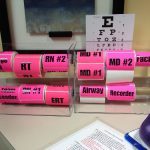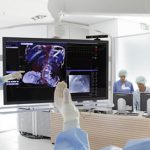Over the years, I’ve seen the trauma teams at quite a few hospitals in action. One thing I have noticed is that most just don’t pay attention to what they wear. I’m talking about wearing personal protective equipment again. It’s one of those things, like hand washing, that everyone knows that they are supposed to do.
There are two reasons to put all that stuff on:
- To keep potentially contaminated body fluids from getting on you
- To prevent you from contaminating your patient’s open wounds
The minimum equipment that MUST be worn is a cap of some sort (to keep your hair from falling on the patient), mask and eye protection (mucus membrane protection), gown (protects your clothes), and gloves (obvious). Shoe protection is optional, in my opinion, unless you wear Christian Louboutin to work.
So you’ve been lax with your team. How do you get them to put everything on now? It’s like getting your child to wear a bicycle helmet when they are fourteen.
- Create an expectation that everyone wear it and empower everyone to point it out. No exceptions. Physicians, this means you.
- Put all equipment just outside the trauma room door. The farther away it is, the less likely it is to be used.
- Assign an enforcer. Everyone entering the room must be dressed, or this person will speak up. Ideally, they should be a physician. If not, one of the docs must back this person up.
- Occasionally, a badly hurt patient gets rolled into the room with little advance notice. In this case the fully dressed people need to relieve those who are not as soon as they dress and walk into the room.
The top picture shows part of our trauma team assembling before a trauma activation. Everyone is dressed. They know that someone will call them on it if they aren’t. Also, note the little pink sticker on the chest of physician at the head of the bed. We have a sticker for every role in the room (bottom picture). At the beginning of a resuscitation I scan the room to make sure everyone has one. It helps identify everyone and makes extraneous personnel stand out so they can be asked to leave the room.
Bottom line: Everyone has to wear their personal protective equipment on every trauma resuscitation. No exceptions.
Related post:



